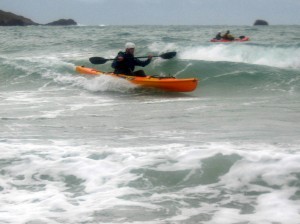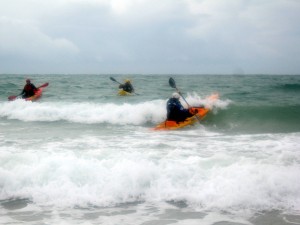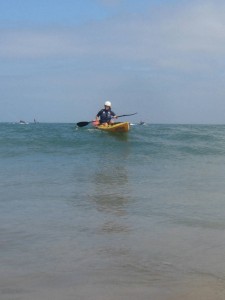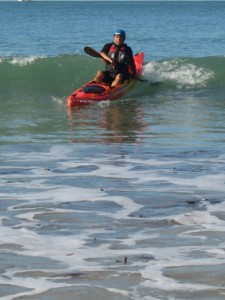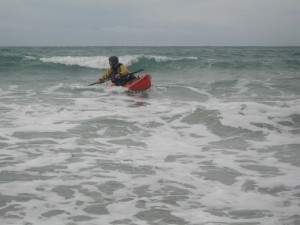BCU 3 star assessment for Sit-on-top sea kayaks part 2
Surf launching and landing skills
It’s easy to arrive at the beach to find a bit of surf stops you getting out fishing with your sit-on-top kayak. Or, you return after a great trip to find the surf has increased. Landing is now a bit of a disaster, though good entertainment for those watching from the shore.
After some surf training at St Brelade bay and Greve d’Azette Andy and Keith started getting the hang of landing and launching through surf and having fun. Both identified small breaks near their homes that will be excellent training grounds. They recognised that these skills will help get them out kayak fishing more often.
Start in small surf and expect to get wet.
Too often paddlers commence in surf that is too big. They battle out through the break and then spend the next hour plucking up the courage to land. As a result there is no learning, only survival!
Make every paddle stroke count
When in surf or rough water don’t ‘tickle’ the water. Make very paddle stroke count.
Give your full commitment when paddling out through surf.
Time the paddle entry just as the wave hits the nose of the kayak and lean forward. This drives the kayak through the wave, reduces the amount of water going up your nose and acts as a bit of a break from being pushed backwards.
As that ‘huge’ wave approaches put in a bit of speed.
As the wave arrives lean forward and drive the paddle into the water.
Acceleration helps. You may also find that hitting the incoming wave with a slight angle helps get your through the break.
As you come through the wave your paddle should switch into a forward paddle stroke to keep you moving.
Launching spots
Check out the best spot to launch from. Swell varies across a beach, yet I often see people paddling out through large surf because it’s closest to where they parked the car. The same applies when landing.
Be slow
In surf it is easy to to accelerate faster than you can react.
Avoid surfing in until you have got the hang of launching and landing in a controlled way.
If you cannot slow down and control your landing you’ll end up surfing. Your skill levels will not keep up with the speed of the surf and you’ll take a swim.
Try to land on the back of the waves and keep the kayak pointing straight. Be prepared to use plenty of stern strokes. They act as both a break and also to help steer the kayak. What you are trying to avoid is the kayak turning side on and accelerating on the wave.
If you do end up side on lean into the wave.
I’ve spent a few sessions with people who have only been shown how to surf in. Usually they have ended up very wet and eating a lot of sand.
After coaching controlled landings and launching in surf we got this feedback:
“On one occasion I chose the wrong wave in the set to launch into and was trying the hand and paddle in the sand technique, so I wasn’t quite gripping my paddle properly when the biggest wave in the set hit me in the chest and pushed me sideways. I instinctively braced, remained upright and paddled out to the rest of the group, a very happy lady with a beaming grin. My first ever ‘combat’ low brace. I don’t know who was more surprised, Andrew or myself. I didn’t stop grinning all afternoon. This success and my increased confidence in dealing with surf is definitely down the my surf training session with Mick. Thanks so much Mick. You’re a star…….”
Land in control
Once you get the hang of this you can let go of the ‘handbrake’ and try surfing in.
Expect to turn sideways to the wave and to accelerate so be ready with the low brace and lean into the wave. Avoid high support strokes (when the knuckles go above shoulder height) unless you want to risk dislocating your shoulder.
Stay safe
Wear a helmet in surf. Both Andy and Keith took a few bangs when they fell in. Keep well clear of other users.
Avoid carrying too much gear on your kayak in surf. It will get ripped off the kayak,lost, broken or even tangled up with you. On one occasion I watched a metal drinking bottle on a lanyard hit a paddler in a face. Ouch!
Stow unneeded gear before you launch or land. There is a lot of power in even the smallest wave.
I do not tend to favour paddle leashes in surf or attaching yourself to the sit on top. Too often the leash gets tangled around a leg or the paddle ends up in odd places. If you do use a leash, carry a knife.
Surf is an excellent place to tune up your skills and get used to big water with the knowledge that the shore is near by.
Things happen quickly in surf and demand a rapid response. Keith got so much fun he ended up surf training two more times that week and feels much more confident in bumpy water as a result.

